Ruth Ellen Gruber's Blog, page 5
August 27, 2013
Hotel to open in famed former Polish Yeshiva building
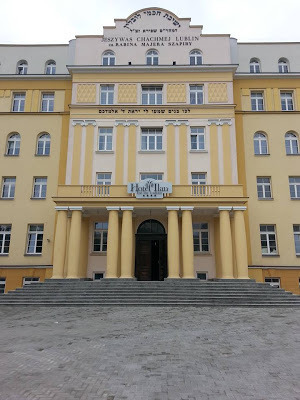 Entry of former Yeshiva building, showing Hotel Ilan sign as well as sign noting its former identity. Photo: Hotel Ilan/Jewish Community Warsaw
Entry of former Yeshiva building, showing Hotel Ilan sign as well as sign noting its former identity. Photo: Hotel Ilan/Jewish Community WarsawBy Ruth Ellen Gruber
Care to spend the night in the building that once housed one of pre-Holocaust Poland's most famous and influential yeshivas?
From October you'll be able to do so, when the four-star Hotel Ilan opens in the huge building in Lublin, Poland, that once housed the Yeshivat Chachmei Lublin, founded in 1930 by Rabbi Yehuda Meyer Shapiro.
According to the Hotel's web site and Facebook page, the new hotel will include 44 rooms, four suites, a restaurant called Olive that will feature Jewish cuisine, a lobby bar, a conference center and a spa/welness center. Its logo includes the slogan “feel the tradition.”
The building is owned by the Warsaw Jewish Community, which will run the hotel. (The community already runs a guest house, Beitenu, located in the former synagogue in Kazimierz Dolny.) That synagogue was used as a movie house after World War II and was restituted to Jewish ownership in 2002. The Beitenu complex also includes a Jewish museum, Judaica and kosher shop, and a cafe.
The Yeshiva function in Lublin only until 1939. After World War II, the enormous building became part of the Lublin medical school. It was returned to Jewish ownership in 2004, and parts of it have been renovated to include a synagogue, mikvah and Jewish communal offices as well as exhibition space.
Published on August 27, 2013 09:52
Romanian Synagogues -- so many sites, so little $$$ .....
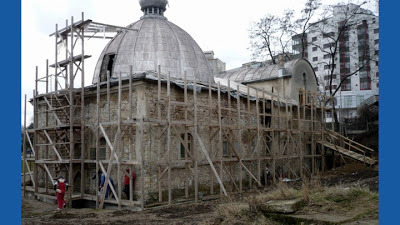 Restoration work has been halted at the 17th century synagogue in Iasi since 2009; seriously endangering the building, the oldest synagogue in Romania. Photo: FEDROM
Restoration work has been halted at the 17th century synagogue in Iasi since 2009; seriously endangering the building, the oldest synagogue in Romania. Photo: FEDROMBy Ruth Ellen Gruber
The full power point of the presentation about Romanian synagogues by Lucia Apostol, of the Federation of Romanian Jewish Communities (FEDROM), at the conference in Krakow in April on Managing Jewish Immovable Heritage, has been posted online on the Jewish Heritage Europe web site. (The full video of her talk is already online here.)
The presentation is a little tricky to read, as the power point slides had to be posted as a photo gallery — and the slides open one by one. But it’s worth it to see the pictures and get an idea of the overwhelming extent of the challenges.
As Lucia points out, while there have been some successful preservation/renovation projects, the challenges are enormous -- and funds are scarce.
FEDROM is responsible for 87 synagogues scattered in all parts of Romania, 34 of which are listed as historic monuments. Only 42 synagogues are still used for religious purposes.
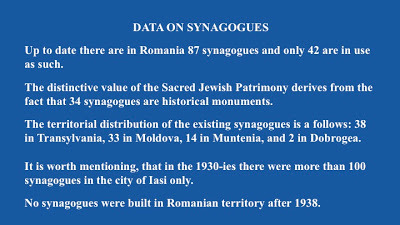
She focused in particular on one horror story -- the botched and stalled restoration of the 17th century synagogue in Iasi, in northern Romania, the oldest synagogue in the country and one of only two synagogue buildings standing in a town that once had more than 100.
Restoration of the building, funded only by the Ministry of Culture and Heritage, began in 2007 but was halted in 2009, when Remicon Ltd, the construction company that had won the bid to carry out the work went bankrupt, leaving the building in a perilous condition, with its future uncertain.
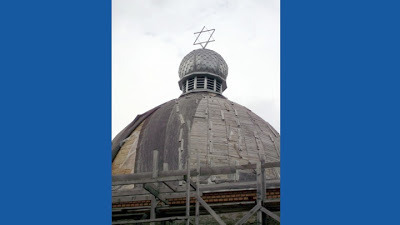 Dome of the Iasi synagogue stripped of protective roofing. Photo: FEDROM
Dome of the Iasi synagogue stripped of protective roofing. Photo: FEDROMIn addition, Apostol noted that FEDROM is responsible for more than 800 Jewish cemeteries, 17 of which are listed as historic monuments -- and many of which have extraordinarily ornate carved decoration. 650 cemeteries are located in towns and villages where no Jews live.
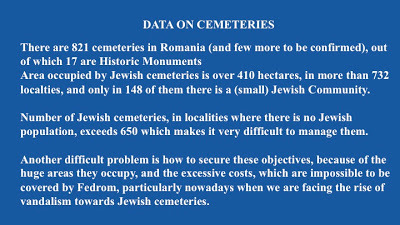
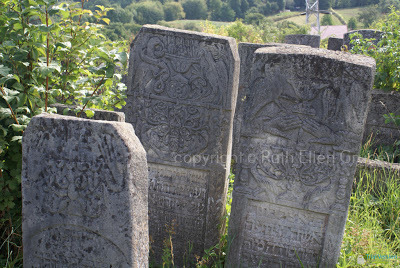 Carved tombstones in the "middle" Jewish cemetery in Siret, Romania. Photo © Ruth Ellen Gruber
Carved tombstones in the "middle" Jewish cemetery in Siret, Romania. Photo © Ruth Ellen Gruber
Published on August 27, 2013 07:47
July 21, 2013
Round-up of Jewish cemetery restoration news in Poland
 Volunteers clearing up the Jewish cemetery in Zambrów. Photo courtesy of FODZ
Volunteers clearing up the Jewish cemetery in Zambrów. Photo courtesy of FODZBy Ruth Ellen Gruber
There's quite a lot going on in Poland regarding the restoration and preservation of Jewish cemeteries, most of which lay neglected and abandoned for decades.
Check out this post on the Jewish Heritage Europe web site for a round up of various initiatives from Żarki, Zambrów, Błędów, Łabiszyn and Strzelno.
It includes a link to a comprehensive Jewish Culture Trail in Żarki financed by local and regional authorities. It takes in the surviving local synagogue (used as a culture center), the surviving Jewish cemetery, houses, shops, urban structure and the WW2 ghetto.
Published on July 21, 2013 07:16
July 20, 2013
Hidden gravestones unearthed at Vienna's oldest preserved Jewish cemetery
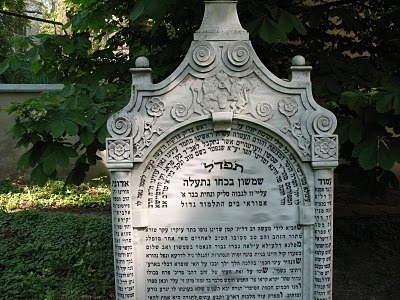 Samson Wertheimer's tomb -- it's actually a mausoleum, and this is one end. Photo © Ruth Ellen Gruber
Samson Wertheimer's tomb -- it's actually a mausoleum, and this is one end. Photo © Ruth Ellen GruberBy Ruth Ellen Gruber
Three years ago, I posted about Vienna's oldest preserved Jewish cemetery, the graveyard on Seegasse that dates from the 16th century, now hidden amid new buildings and entered through an old-age home on the site of what was a Jewish hospital. Many 17th and 18th century luminaries are buried here, including the financier and Court Jew Samuel Oppenheimer (who founded the Jewish hospital and restored the cemetery at the end of the 17th century) and Samson Wertheimer, who succeeded him as Court Jew.
News has now come that during the ongoing restoration of the cemetery, an important trove of buried matzevot has been discovered. According to Jewish community officials in Vienna, the stones appear to have been among those that were buried there in 1943 to protect them from the Nazis. A score of stones have been recovered in recent weeks, but hundreds more may be buried, according to Vienna Jewish officials.
It has long been known that gravestones from Seegasse were buried for protection during World War II – as I noted in my post in 2010, the guidebook “Jewish Vienna” published in 2004 by Mandelbaum Verlag, wrote that some were buried them on the spot and others were transported to the Central Cemetery and buried there.
In the mid-1980s, after the discovery of these stones, the cemetery underwent a full restoration -- and the surviving stones were set up in their original places thanks to a map of the cemetery that had been made in 1912. Many of the stones are massive and feature elegant calligraphy, lengthy epitaphs and some vivid carving of Jewish symbols and floral and other decoration, similar to that on tombs in the Jewish cemetery in Mikulov, Czech Republic, and elsewhere in Moravia. Fragments that could not be put together were used to construct a memorial wall, similar to those that exist in other countries at restored cemeteries.
The Associated Press published pictures of the new find and reported:
Vienna’s Jewish leaders say it is not clear exactly how many were buried by the small group of Viennese Jews determined to save their heritage from the Nazi bulldozers. They also say they have few further details of the act, with none of the participants surviving the Holocaust and their location unclear — until now.
After workers scored the ground with radar as part of restoration work, they say they are sure there are hundreds beneath the grass. The 20 unearthed in the past few weeks have convinced officials they have a historically significant find, they said.
Raimund Fastenbauer, a senior official with Vienna’s Jewish community, told The Associated Press on Wednesday that he believes many of the up to 600 missing stones are still below ground and partially or fully recoverable.
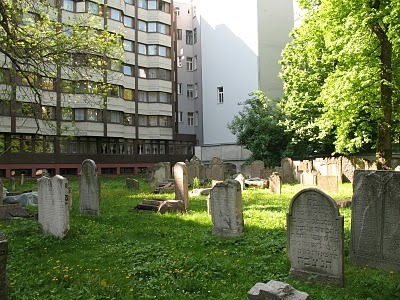 Seegasse cemetery, surrounded by buildings. Photo © Ruth Ellen Gruber
Seegasse cemetery, surrounded by buildings. Photo © Ruth Ellen Gruber
Published on July 20, 2013 10:41
My reflections on the Krakow Jewish Culture Festival
 Steve Weintraub & heads of carved Jewish figurines. Photo © Ruth Ellen Gruber
Steve Weintraub & heads of carved Jewish figurines. Photo © Ruth Ellen GruberI’ve been writing about the Jewish Culture Festival in Krakow for about 20 years, maybe even longer…so I have some historical perspective and memory in its regard.Here’s my latest piece, a first-personer published in The Forward. People who also have long experience with the Festival and with the Jewish development of Krakow praised it for presenting a nuanced view….other people, predictably, didn’t get what I was getting at…Onward and Upward with Matisyahu in KrakowARTS FEST SHOWS TRANSFORMATION IN POLAND’S REPUTATION
By Ruth Ellen GruberJuly 19, 2013KRAKOW — In the sultry darkness of a summer night, a tall, skinny figure with close-cropped hair and a purple T-shirt threaded through a beer garden during Krakow’s Jewish Culture Festival, the annual nine-day extravaganza of performance, exhibition, debate and intensive interaction that for a quarter of a century now has been a catalyst of Krakow’s Jewish cultural revival.Bridging the open space between the city’s lively Jewish community center, which hosted dozens of festival events, and the grandiose Tempel Synagogue, venue for many of the concerts, the garden served as an informal salon where public and performers, Jews and non-Jews alike, could shmooze.Whispers trailed in the newcomer’s wake: “Matisyahu’s here!”The American singer, much less recognizable since he shed his Hasidic garb, blended with the dozens of other folks sipping their drinks as he made his way through the slatted wooden tables and sat down with a group that included Jonathan Ornstein, director of Krakow’s Jewish community center, and Janusz Makuch, the bearded, non-Jewish Pole who co-founded the festival in 1988 and is still both its director and its main driving force.Matisyahu wasn’t on the program, though he has performed here in the past.This time, en route to a gig in northern Poland, he had simply dropped in to hang with the festival crowd in Kazimierz, Krakow’s historic Jewish district.Over the past two decades, Kazimierz has famously been transformed from a rundown slum, the quintessential Jewish graveyard, into a major tourist attraction: a burgeoning hub of revitalized Jewish culture, life, consciousness and commercial kitsch — as well as the city’s liveliest center of clubs, pubs and other late-night venues.“We must have been out till 5 in the morning,” Ornstein told me the next day.I’ve been writing about Kazimierz since 1990 and about the festival itself for nearly that long, returning each summer, at least for a few festival days, to monitor changes in the place, the program and the issues that swirl around both of them.To me, Matisyahu’s under-the-radar appearance brought home one of the most striking of these changes. Clearly for him — and for the hundreds, maybe thousands, of other Jewish tourists who now flock here — the long post-Holocaust taboo on visiting Poland for pleasure has been broken.This is no mean feat and has taken years to come about. Auschwitz is just an hour’s drive from Krakow, and the new attitude is by no means universal. But I heard it echoed clearly by a Canadian woman staying in my hotel.“There’s no downside to Krakow,” the woman told me over breakfast. “As for the festival, it’s great. I’m doing as many activities as I can, and I’m already planning to come back with friends in two years.”One of the factors in this change has been the increasingly high profile of the JCC, which opened five years ago as a neutral Jewish space accessible to all streams and forms of Jewishness and Jewish expression, normative or not.Now one of the hubs of the festival, the JCC is, importantly, recognized as a “Jewish” Jewish space, in contrast to most of the city’s other Jewish-oriented venues and institutions. Its involvement has changed radically the dynamics of an event that long was viewed as a Jewish festival produced by non-Jews for a non-Jewish audience. Non-Jewish Poles still make up the vast majority of the festival’s attendees.Among the JCC’s annual festival offerings is a kosher Sabbath dinner. This year, hosted in the 17th-century Izaak Synagogue, the dinner drew nearly 400 people.“Visitors to Krakow now understand that they are not coming to a museum, but rather to a place with a small but increasingly active Jewish community,” Ornstein told me. “Understanding that fact puts the festival in a different context from a Jewish point of view. It is not only connecting Poles to Jewish culture, but helping create an environment in which the local Jewish community feels welcome and can thrive. This festival can make a claim that few others can: It is helping to rebuild a Jewish community long thought by many to be without a future.”This year, the concepts of “Jewish” and “Jewishness” — and the ways they are defined, perceived, described and enacted — formed one of the main themes confronted in the many festival lectures, workshops and discussions.I took part in a public conversation at the JCC, called “Jewish. Jewish? ‘Jewish’ Jewish!” It addressed shifting definitions, particularly in Kazimierz, where the transformations have created a complex of new Jewish authenticities that are quite different from the Krakow Jewish world that was destroyed in the Holocaust but are still real components of today’s living city.After all, few if any of the young Poles and visitors who now throng the district’s many new cafes or volunteer at the JCC have any direct memories of Kazimierz before the festival began drawing crowds, when no modern Jewish museums and culture centers offered their programs, and no Jewish (or Jewish-style) commercial venues plied their trade.“The resonance of the festival has become larger than the festival itself. And maybe this is the important thing,” the noted Yiddish singer Michael Alpert commented backstage during the festival’s traditional marathon open-air final concert on Kazimierz’s main square, Szeroka Street. “There’s ‘normalization,’” Alpert said, “and if it’s normal, it’s not as exotic.”Nonetheless, he said, the festival’s main museum exhibition demonstrated an unsettling deep-seated sense of the “weird” that still surrounds Jewish issues.This provocative show confronted the perception of what is understood as Jewish or “Jewish.” Titled “Souvenir, Talisman, Toy” and curated by Concordia University anthropologist Erica Lehrer, it explored the history, meaning and symbolism of the ubiquitous carved wooden figurines of Jews, frequently seen at Polish souvenir stalls and which often perpetuate sometimes toxicstereotypes.The exhibit placed these figures in the context of both folk art and folk fantasy. In doing so, particularly against the pervasive good vibes of the festival, it served to highlight — and confront — the contradictory ways that “Jews” and “Jewishness” are perceived and represented in contemporary Poland.One particular focus was on the myriad “Jewish” figures that clutch money and are used as “good luck” charms said to bring purchasers prosperity. Some observers actually view such “penny Jews” as embodying “positive” stereotypes, without ill intention. In exhibition video interviews, vendors and purchasers alike spoke openly about the magical properties of such figures, some of which are so abstract that, though bought, sold and recognized as “Jews,” they look more like aliens than human beings.“As a Jewish dancer, people look at my physicality as a Jew,” said Steve Weintraub, the festival’s Jewish dance teacher, with whom I visited the exhibit. “What does this mean about how people are seeing me?”That, of course, was the question. Or one of the questions. Only days after the festival’s conclusion, the lower house of Poland’s parliament voted down a bill that would have allowed Jewish (and Muslim) ritual animal slaughter.It’s not for nothing that the exhibition advertisement featured the grotesque head of a wooden Jew, all staring eyes, fur hat and flaring peyes, or sidelocks. From posters and banners it glared proudly — even defiantly — out at the manifold new realities of Jewish Kazimierz with an expression of amazement, inquiry and possibly apprehension.
Read full article at: http://forward.com/articles/180634/onward-and-upward-with-matisyahu-in-krakow/?p=all#ixzz2ZaSVeCa9
Published on July 20, 2013 05:25
June 13, 2013
Big events in Poland next weekend

by Ruth Ellen Gruber
(This post also appears on my En Route blog for the LA Jewish Journal)
Two long-awaiting events are happening in Poland next weekend -- the opening of the Jewish museum installed in the restored synagogue in the little town of Chmielnik, and the opening of the restored synagogue in the town of Wielkie Oczy, which will now be used as the public library.
I've actually never seen the elegant synagogue in Wielkie Oczy, located in the southeastern corner of Poland on the Ukrainian border -- but I have long loved it from its photographs: its state of disrepair made it a particularly poignant image. Distinguished by its arched windows and doors, it was built in 1910 but rebuilt in 1927 after suffering serious damage in World War I. It was long used as a warehouse and office after World War II but had languished derelict for years in a steadily deteriorating condition.
A series of events on June 16 will celebrate its reopening after a restoration funded by the town, with support from the Foundation for the Preservation of Jewish Heritage in Poland. These will include the unveiling of a memorial plaque to the destroyed Jewish community, speeches, and a concert.
The development of the Jewish museum in Chmielnik, north of Krakow, is something that I have followed for years -- and it all comes to fruition June 15-16, with two days of events including a conference, concerts, talks and more.
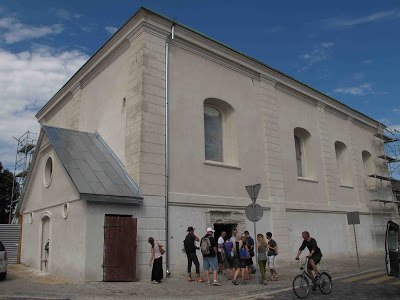 Partially restored synagogue, July 2012. Photo © Ruth Ellen GruberI first saw the ruined synagogue, one of the largest buildings in the little town, back in 1990, when I made my first forays into documenting Jewish heritage sites. Originally built in the 1630s, it was, though derelict, still a splendid building, a massive masonry structure with barrel vaulting. The Nazis turned it into a warehouse, but the interior still retained stucco work dating from the 18th century, and the walls still bore traces of delicate polychrome decoration, including frescoes of lions, neoclassical geometric forms, and signs of the zodiac.
Partially restored synagogue, July 2012. Photo © Ruth Ellen GruberI first saw the ruined synagogue, one of the largest buildings in the little town, back in 1990, when I made my first forays into documenting Jewish heritage sites. Originally built in the 1630s, it was, though derelict, still a splendid building, a massive masonry structure with barrel vaulting. The Nazis turned it into a warehouse, but the interior still retained stucco work dating from the 18th century, and the walls still bore traces of delicate polychrome decoration, including frescoes of lions, neoclassical geometric forms, and signs of the zodiac. 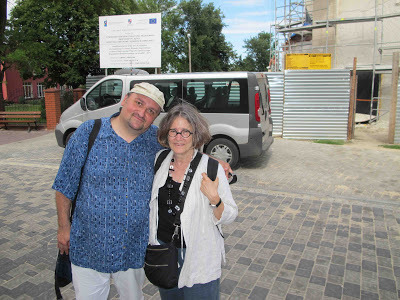 Me and Piotr Krawczyk outside the synagogue under renovation, July 2012.
Me and Piotr Krawczyk outside the synagogue under renovation, July 2012.About a dozen years ago, young local activists, in particular Piotr Krawczyk, became interested in the Jewish history of the town -- which Krawczyk noted to me actually meant the history of the town: before the Holocaust, Jews made up about 80 percent of the population, but their memory and the memory of their contribution was long suppressed or forgotten.
Inspired by the Jewish Culture Festival in Krakow, Krawczyk and other activists, cooperating with the municipality, launched an annual Jewish culture festival in Chmielnik, held each June. They also started other initiatives, including clean-up of the ravaged Jewish cemeteries and erection of the memorial, as well as a web site about Jewish heritage, history and culture of the region.
The museum project has been the most ambitious project, entailing the renovation and transformation of the synagogue -- the design has been somewhat controversial because of a glass bimah installation.
Published on June 13, 2013 09:43
June 9, 2013
Belatedly.... links to the Jewish heritage conference in Krakow
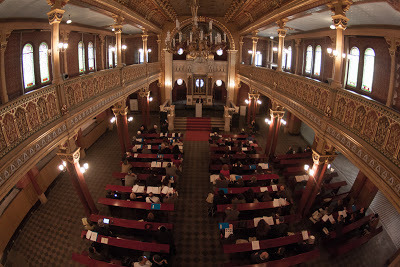 Opening plenary. Photo: JCC Krakow
Opening plenary. Photo: JCC KrakowBy Ruth Ellen Gruber
I know, I've really let things slide on this blog. Partly it's because there has been so much going on that I have not found time to write a decent post. Partly it's because I've been putting a lot of energy into the news feed of the web site www.jewish-heritage-europe.eu, which I coordinate as a project of the Rothschild Foundation (Hanadiv) Europe. I urge everyone to subscribe to the Jewish Heritage Europe news feed -- you can do it from the home page of the web site, or from any of the news pages. (And -- why not like us on Facebook and follow us on Twitter, too...?)
One of my main projects over the past few months, linked to Jewish Heritage Europe, was being the main hands-on organizer of the working seminar on Managing Jewish Immovable Heritage, which took place in Krakow April 23-25. Our partner on the ground in Krakow was the Jewish Community Center, whose young staff and volunteers were fantastic to work with and did an extraordinary job and making everything work....and everyone agreed that the kosher food provided from the JCC kitchen was the best anyone had ever had at such a gathering.
We had about 100 participants from about 20 or 22 countries -- as broad a mix of people involved in Jewish heritage preservation, documentation and promotion as possible: culture ministry representatives; Jewish community representatives; academics; architects and architectural historians; grass-roots activists -- and more.
All the sessions (except for a session with funders) were recorded -- and I have posted all of them, in their entirety -- on the web site. Click here to see them . I have also posted the texts or power points of some of the presentations.
There were three plenary sessions -- an introductory session with keynote by Samuel D. Gruber; a session on managing Jewish heritage in Poland; and a summing up "looking toward the future" session. All were held in the ornate, 19th century Tempel Synagogue, in mark to mark the 20th anniversary of the start of the restoration of that building.
Published on June 09, 2013 13:27
April 22, 2013
Managing Jewish Built Heritage Conference this week -- opening to be live-streamed
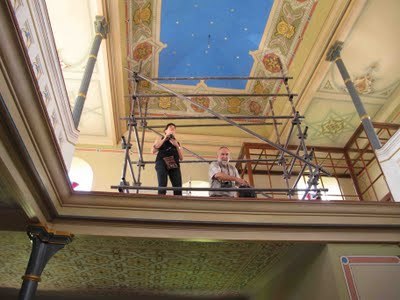 Restoration work in synagogue in Spisske Podhradie, Slovakia, 2011. Photo © Ruth Ellen Gruber
Restoration work in synagogue in Spisske Podhradie, Slovakia, 2011. Photo © Ruth Ellen GruberBy Ruth Ellen Gruber
This post also appears on my En Route blog for the LA Jewish Journal
I've spent much of the past five or six months working on the organization of an international conference called Managing Jewish Immovable Heritage in Europe: A Working Seminar on Projects, Challenges and Strategic Thinking -- a three-day, invitation-only working seminar convened to discuss a wide range of issues, challenges, strategies and successes regarding the care, maintenance, preservation, use and promotion of Jewish material heritage. It is a direct follow-up to a seminar on Jewish heritage management that took place in Bratislava, Slovakia, in March 2009 and issued the Bratislava Statement, including best practices recommendations.
The conference takes place April 23-25.
The opening session April 23 will take place in the historic Tempel Synagogue, whose restoration, spearheaded by the World Monuments Fund and initiatied in the early 1990s, was one of the first major post-communist Jewish heritage restorations in Poland.
The session -- at 2 p.m. CET -- will be live streamed on internet. Keynote speaker will be Dr. Samuel D. Gruber, a pioneer in Jewish heritage preservation and documentation. You can watch it on the www.jewish-heritage-europe.eu web site, or right here:
The seminar is being convened by the Rothschild Foundation (Hanadiv) Europe; the David Berg Foundation; the Cahnman Foundation, the American Jewish Joint Distribution Committee; the World Monuments Fund; and the Taube Foundation, in cooperation with the Foundation for the Preservation of Jewish Heritage in Poland; the Jewish Community Centre in Krakow; the Galicia Jewish Museum in Krakow; and the European Council of Jewish Communities. The U.S. Commission for the Preservation of America’s Heritage Abroad will also have a presence.
WHY: The restitution of Jewish property seized by the Nazis or nationalized by post-war communist regimes has been a hot-button international issue since the Iron Curtain fell. But the slow and often painful legal battles to gain restitution have often overshadowed the pressing practical concerns of what to do with such properties, whether they are owned by Jewish communities or by others. Many of them are huge. Many are dilapidated. Many are recognized as historic sites. And most stand in towns where few if any Jews now live. Even basic care and maintenance can stretch already strapped financial and professional resources. How to preserve, manage and promote these historic Jewish properties is a key issue faced by Jewish communities, civic bodies, NGOs., governments, municipalities, grassroots activists and others.
WHO: About 90 invited participants from about 20 countries, including experts in the field as well as a variety of direct stakeholders: Jewish community representatives, grassroots activists, NGOs, civic bodies, funders, researchers, government officials, etc.
ISSUES: Sessions will examine the issues that arose and the recommendations that emerged out of the Bratislava meeting, as expressed in the final Bratislava Statement of best practices. They will also consider new conditions that have arisen in the past four years – including new technology developments; the financial crunch and changed funding possibilities; changed local attitudes, etc. – and look toward the future.
The meeting will include general discussion as well as thematic workshops, and there will be a half-day trip to visit Jewish heritage solutions near Krakow.
Focal points of discussion will include:
– Sharing experience/strategic thinking: Though each situation is specific, there are many shared problems and needs that can be addressed collectively. Importantly, there are also solutions that can be shared.
– Making information available/using new digital technologies: Information on Jewish sites is most useful when it is most widely available. Efforts should continue and expand to make documentation available in publicly accessible research centers and through publications and on-line presentation, all the while considering safety, security and privacy concerns. New technology – ranging from smartphone apps to digital documentation to enhanced scanning – needs to be addressed as part of research, documentation and promotion of Jewish heritage.
– Networking and collaboration/strategic thinking: Jewish communities and institutions should work together as much as possible to share existing information, methodologies and technologies, and to develop new and compatible goals and strategies to optimize the care and management of historic Jewish properties. They should also seek partners among NGOs, local, civic and government bodies, and individuals outside the Jewish community. And vice versa.
– End-user development: Jewish communities and local heritage, cultural and tourist bodies (as well as NGOs, civic bodies, individuals and others) should work together to develop regional, national and trans-border heritage routes as well as local projects.
CLICK HERE TO SEE THE CONFERENCE PROGRAM, INCLUDING SPEAKERS
Published on April 22, 2013 03:37
April 16, 2013
Door into Presov synagogue, Photo © Ruth Ellen GruberBy R...
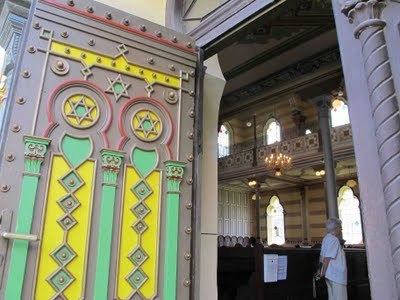 Door into Presov synagogue, Photo © Ruth Ellen Gruber
Door into Presov synagogue, Photo © Ruth Ellen GruberBy Ruth Ellen Gruber
Over the years I have traveled to many Jewish heritage sites all over Slovakia, and I have closely followed the development of the Slovak Jewish Heritage Route -- I have posted much in the past on my Jewish Heritage Travel blog. See some of those posts HERE
In its current edition, Hadassah Magazine publishes a lengthy article I wrote detailing this route, the brainchild of tmy friend Maros Borsky.
A far-reaching project ... aims to safeguard key sites of Slovak Jewish heritage while using them as tools to integrate Jewish history and memory into local tourism, culture and education.
This is the Slovak Jewish Heritage Route (www.slovak-jewish-heritage.org), a tourist and educational trail that links two dozen key sites in all eight regions of the country—synagogues and Jewish cemeteries, but also Jewish museums and Holocaust memorials.
Formally launched in 2007, the route is the brainchild of Maros Borsky, Slovakia’s foremost Jewish scholar, who convinced communal leaders to focus scarce resources on a few significant places to ensure their long-term survival.
“The only way to preserve these buildings is to find a different use for them, predominantly and preferably for cultural purposes,” Borsky says. “And what is very important is to generate an audience for them. There is no point in putting money into restoring these buildings if no one will use them.”
Read the whole article
In the piece, I list and profile most of the sites on the Route -- north, south, east and west.
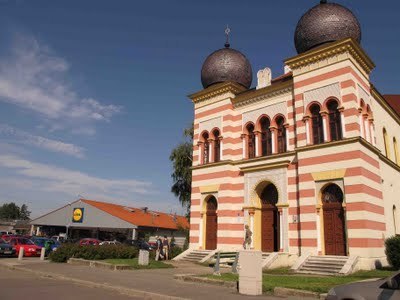 Synagogue in Malacky, now an art school. Photo © Ruth Ellen Gruber
Synagogue in Malacky, now an art school. Photo © Ruth Ellen Gruber
Published on April 16, 2013 15:29
Museum of the History of Polish Jews dedicated at last
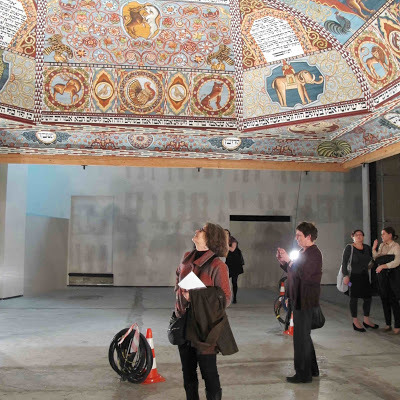 I view the spectacular painted Gwozdziec ceiling
I view the spectacular painted Gwozdziec ceilingBy Ruth Ellen Gruber
This post also appears in my En Route blog for the LA Jewish Journal.
I've been in Warsaw for events marking the 70th anniversary of the Warsaw Ghetto Uprising -- and filed a story for JTA on the "soft" opening of the long-awaited, long-delayed Museum of the History of Polish Jews.
Though I am not in love with the exterior of the buildng -- except for its location opposite the Warsaw Ghetto Heroes Memorial -- I was very impressed with the interior. In particular the way the big glass gash of an entrance frames the memorial when you look out from inside.
For me, who has followed the development of the museum for nearly 20 years, it was a rather emotional (and emotionally satisfying) moment to finally be inside -- and to connect and reconnect with so many people I've encountered here in Poland since the 1980s.
WARSAW, Poland (JTA) -- Krzysztof Sliwinski, a longtime Catholic activist in Jewish-Polish relations, gazed wide-eyed at the swooping interior of this city's Museum of the History of Polish Jews.
Nearly two decades in the making, the more than $100 million institution officially opens to the public this week amid a month of high-profile, state-sponsored events marking the 70th anniversary of the Warsaw Ghetto Uprising.
“It’s incredible, incredible, incredible how things have changed,” Sliwinski told JTA. “I remember commemorations of the ghetto uprising under communism when only a few people showed up. How good it was that we were optimistic.”
Sliwinski organized Jewish cemetery cleanups and other pro-Jewish initiatives under communism, when Jewish practice and culture were suppressed by the regime.
In 1995, then-Foreign Minister Wladyslaw Bartoszewski, an Auschwitz survivor, appointed him post-Communist Poland’s first official ambassador to the Jewish Diaspora, part of the state’s unprecedented outreach policy.
On Sunday, both Sliwinski, now 73, and Bartoszewski, 91, joined hundreds of local Jews and other VIPs as Poland’s chief rabbi, Michael Schudrich, unveiled a mezuzah at the museum’s main entrance.
Read the full story
In writing this piece, it was fascinating to go back and see what I -- and others -- had written back in the 1990s.
New York Times 1996 piece on opposition/ambivalence regarding the museum project
My 1996 story on Sliwinski as Poland's ambassador to the Jewish Diaspora
Published on April 16, 2013 15:17



